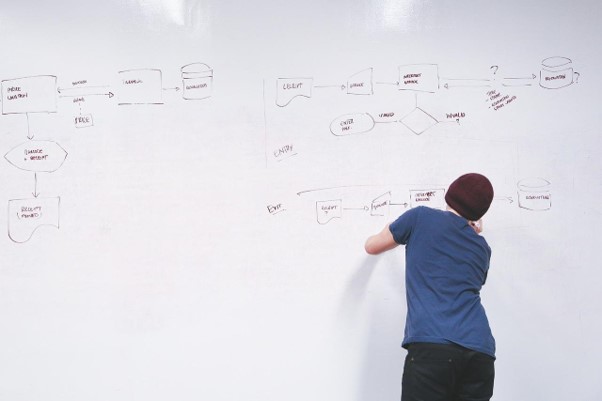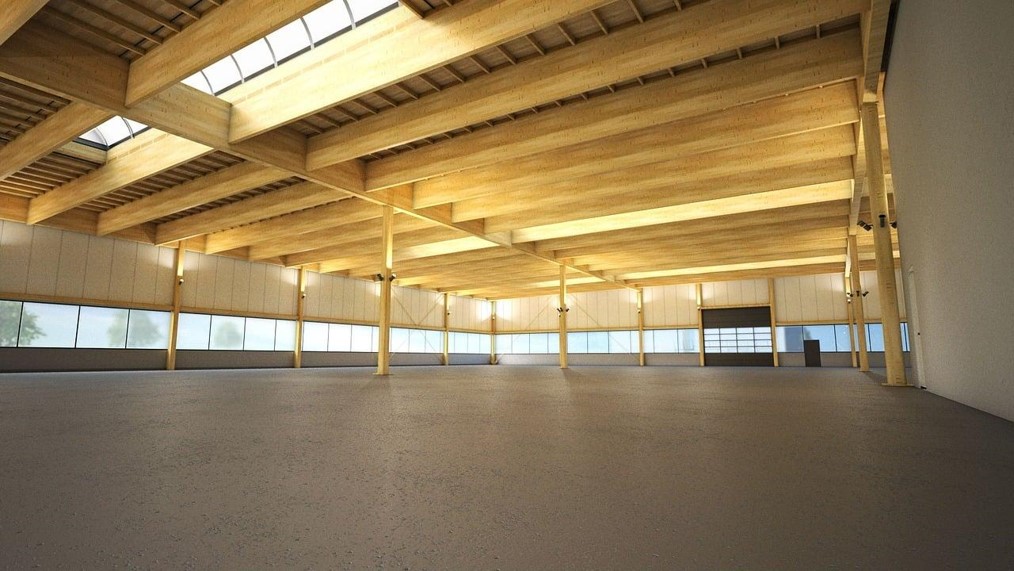

MakMax Plus
How farmers can improve their earnings by utilizing the MAFF’s “Production Area Production Base Power Up Project”.
2020.11.17

If we could install more expensive machines and facilities, we could generate more revenue…”
We want to rehabilitate our agricultural greenhouses and pass them on to the next generation!”
There is a system that we would like such farmers to know about. Have you ever heard of a subsidy program called the “Power Up Production Base Project for Production Areas”?
Please read through this article and don’t be put off by the mere mention of the word “grant. We will provide detailed and concise tips on how to improve profitability.
Table of Contents
- 1. What is the Power Up Project for Production Bases in Production Areas?
- 2. Three policies of the Power Upgrade Project for Production Bases in Production Areas
- 2-1. Measures to acquire new markets
- 2-2. Profitability improvement measures
- 2-3. Measures to strengthen production infrastructure
- 3. Procedures
- 4. Examples of Utilization
- 5. Summary
What is the Power Up Project for Production Bases in Production Areas?

One of the Ministry of Agriculture, Forestry and Fisheries’ programs that financially subsidizes farmers who aim to increase their profits or strengthen their production base is the “Production Area Production Base Power Up Program. A certain amount of the cost can be subsidized for efforts to introduce high-performance machinery and facilities, to change cultivation systems, and to cultivate the soil through the use of compost.
The following three policies are differentiated according to the nature of the initiatives, each with different targets and conditions.
- Measures to capture new markets
- Profitability improvement measures
- Measures to strengthen the production base
In this article, we will review each of these in detail, and finally, we will introduce the process of the procedure and examples of actual use.
Three policies of the Power Up Production Base Project in the production area
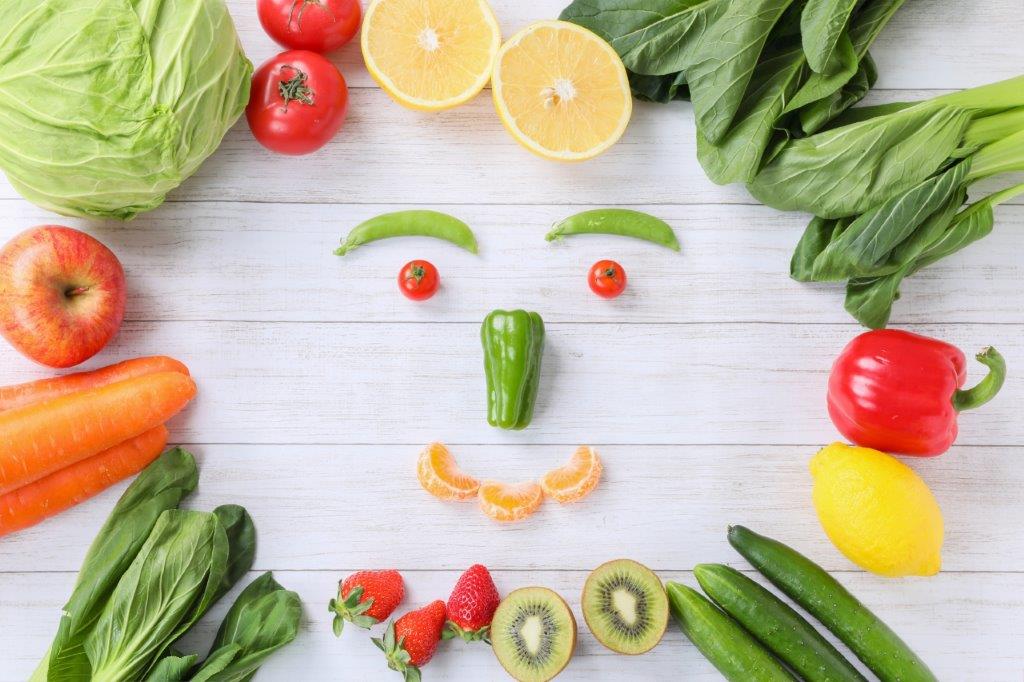
Each of the three policies of measures differs in terms of the projects to be subsidized, the subsidy rate, and the requirements for adoption. We have organized each of these policies, so please check to see if any of them apply to your case.
Measures to capture new markets

The “New Market Acquisition Measures” program, part of the “Production Area Production Base Power Up Program,” subsidizes the cost of facility development, etc., with the aim of fostering base businesses that will become the nucleus of new markets and strengthening farmers’ production and shipping systems through cooperation with food-related businesses and other base businesses. Both hard and soft aspects are eligible for assistance, for example, they will support the following initiatives
[Hardware].
- Development of processing facilities for domestically produced frozen vegetables
- Cold chain development for exports
- Integrated storage facilities for fruits and vegetables for processing and commercial use, etc.
[Soft] [Soft
- Introduction and lease introduction of agricultural machinery, etc.
- Establish a labor adjustment system to address labor shortages, etc.
- Introduction of growth forecasting systems, etc.
Initiatives eligible for support
To be eligible for support, the product must be positioned in the “Collaborative Business Plan” described below, and must aim to capture new markets such as overseas and for processing and commercial use.
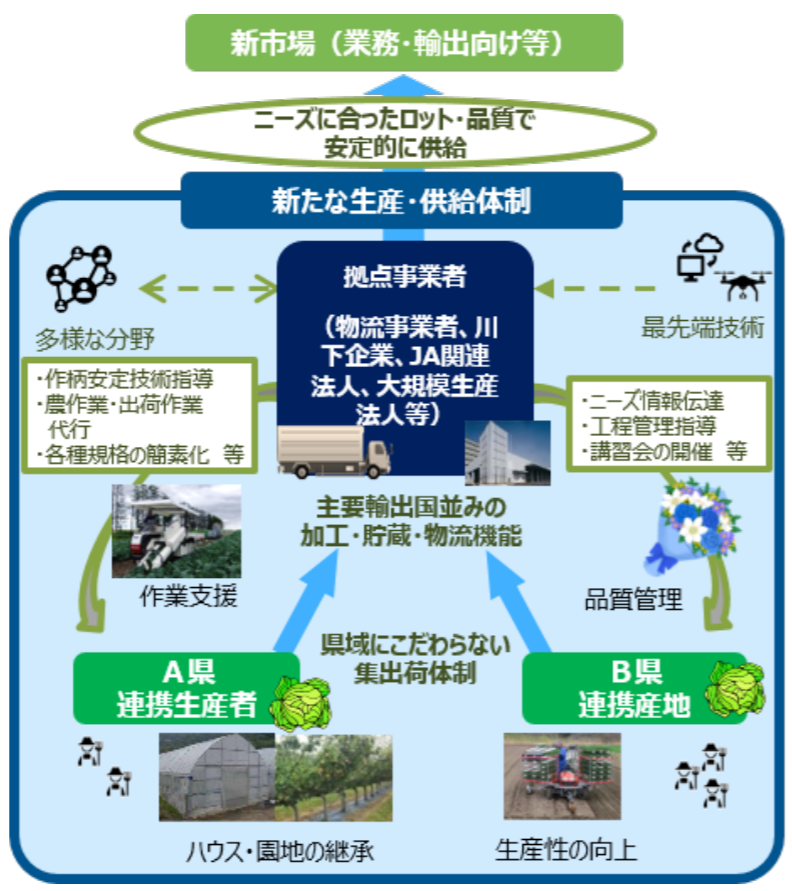
(Source: Ministry of Agriculture, Forestry and Fisheries website)
Outline of Collaborative Project Plan
The collaborative project plan will be developed in the following steps.
(i) Forming a group of farmers, etc. that has the following three functions and cooperates with the base business operators who provide production support, etc.
- Production stabilization and efficiency functions
- Supply adjustment function
- Function to meet the needs of actual customers
(2) Prepare a plan within three years that sets goals that meet the following two criteria.
- Increase the ratio of shipments to exports to total shipments by an average of at least 1 percentage point per year
- Increase the ratio of shipments for processing and commercial use to total shipments by an average of at least 3 percentage points per year, and begin export initiatives by the target year
(iii) Approval of the Director-General of the Production Bureau, Ministry of Agriculture, Forestry and Fisheries
Supported by
- Base operators positioned in the above collaborative project plan
- Its collaborators (farmers, private businesses, etc.)
Subsidy Rate and Maximum
Subsidy rate
- Hard: within 1/2
- Soft: within 1/2, etc.
upper limit
- Hardware: 2 billion yen
- Software: 50 million yen
Profitability improvement measures

As the name suggests, “Measures to Improve Profitability” subsidizes the cost of installing necessary agricultural machinery and improving collection and shipping facilities for farmers who make plans to strengthen their profitability and work toward achieving this goal.
For example, they will financially subsidize a certain percentage of the following activities
- Development of key facilities in the production area, such as agro-processing and processing facilities and low-cost weatherproof greenhouses
- Lease introduction and acquisition of agricultural machinery
- Introduction of production materials
The support will be provided on the two main conditions that the “Outcome Goals” meet the criteria described below, and that the “Area Requirements” and other conditions are met.
Supported by
Farmers participating in the “Production Area Power Up Plan (Profitability Improvement Type)” prepared by the Regional Agricultural Revitalization Councils, etc., and farmers’ organizations such as the following are eligible.
- agricultural cooperative
- agricultural cooperative
- qualified agricultural land ownership corporation
- Other organizations organized by farmers
Individual management entities are also eligible to participate.
outcome objective
The entire production area must set goals that fall into one of the following seven categories and develop and implement a plan to achieve them. It is important to note that this is not the goal of the farmer or agricultural organization installing the machinery or equipment, but the goal of the entire production area.
- Reduction of at least 10% of production costs or collection, shipping, and processing costs
- Increase of 10% or more of sales or income
- An increase of at least 10% of the percentage of contract cultivation and at least 50% of the percentage of contract cultivation
- 100% conversion rate from products and varieties expected to decrease in demand to products and varieties expected to increase in demand
- If there is an export track record, an increase of 10% or more in the volume or value of shipments destined for export
- If there are no new export initiatives or no export results in the most recent year, at least 5% of total shipments or at least 10 tons per year of shipments for export.
- At least 10% increase in labor productivity
area requirement
Area requirements are set individually for each commodity, with further exceptional measures to relax the requirements under certain conditions. For example, if the project is implemented in a mountainous area, the area requirement is relaxed as shown in the table below.
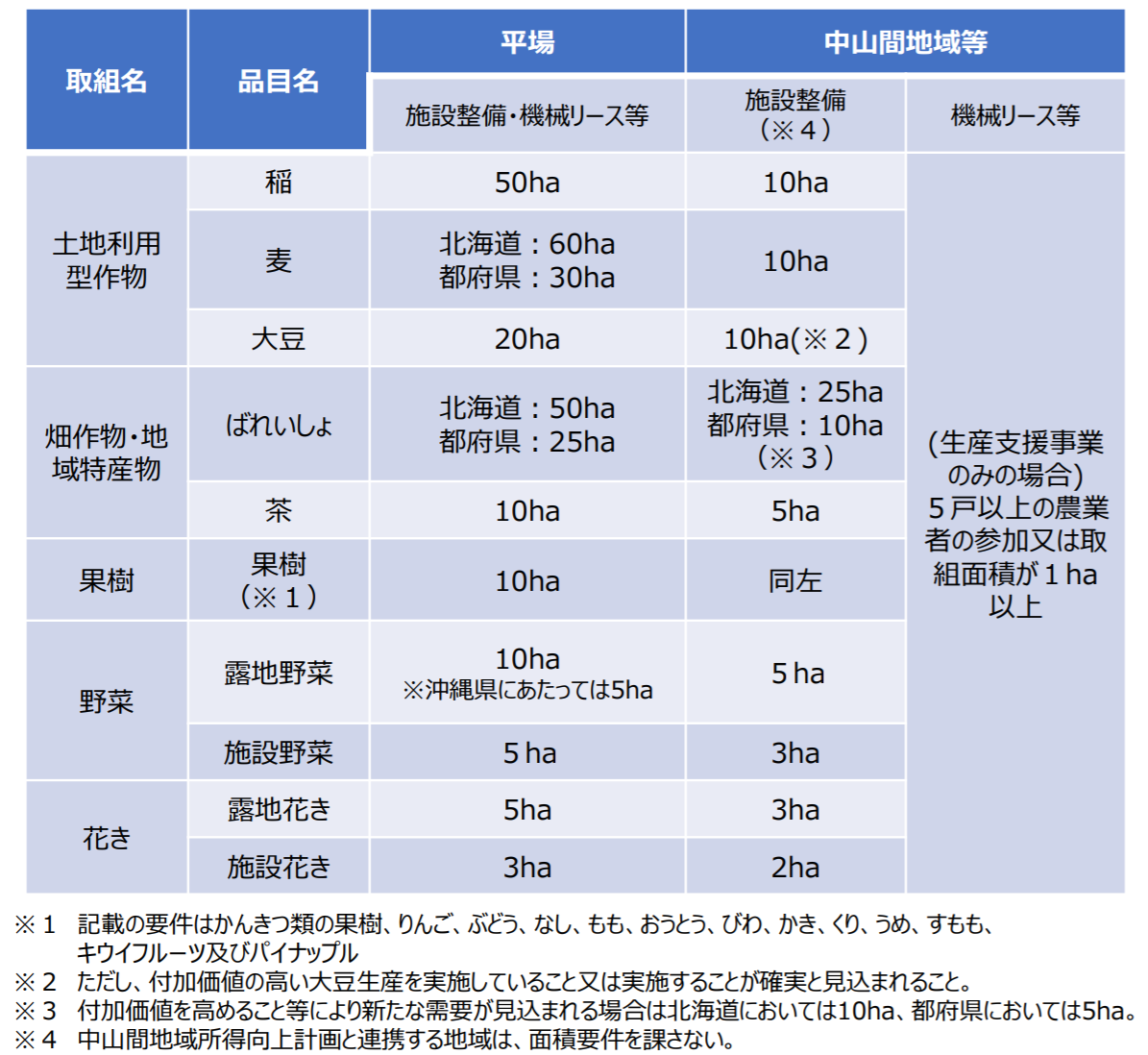
(Source: Ministry of Agriculture, Forestry and Fisheries website)
If you would like to confirm details, please contact the “Inquiry Desk” of the Ministry of Agriculture, Forestry and Fisheries.
Please note that the area requirement, as with the above-mentioned performance targets, is not a requirement to be met individually by farmers and agricultural organizations that introduce machinery and equipment, but by the entire production area as a whole.
The following diagram provides a clear image.
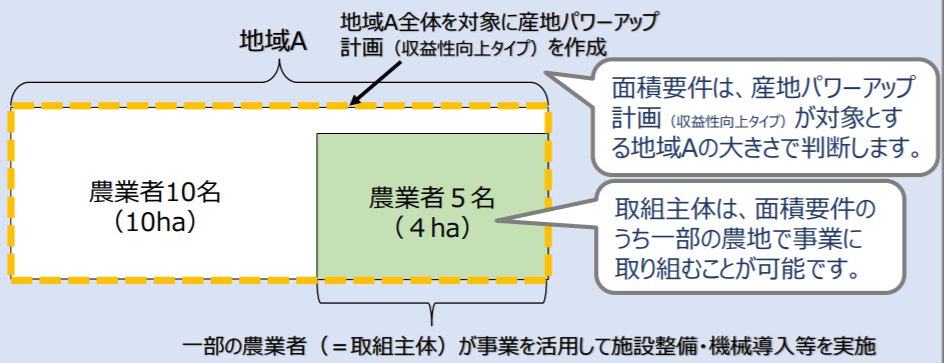
(Source: Ministry of Agriculture, Forestry and Fisheries website)
Initiatives eligible for support
The two main types of projects are defined as “maintenance projects” and “fund projects (production support projects and effectiveness promotion projects)”.
Maintenance projects
- Development of drying and preparation facilities
- Development of grain drying, preparation and storage facilities
- Development of collection, shipping and storage facilities
- Development of agricultural product processing facilities
- Development of facilities for advanced production technology (low-cost weatherproof greenhouses, etc.), etc.
Fund projects (production support projects and effectiveness promotion projects)
- Leasing and acquiring high-performance agricultural machinery to reduce costs
- Introduction of production materials required for high value-added production, such as rain shelter greenhouses
- Replanting of competitive varieties of fruit trees with the same varieties, etc.
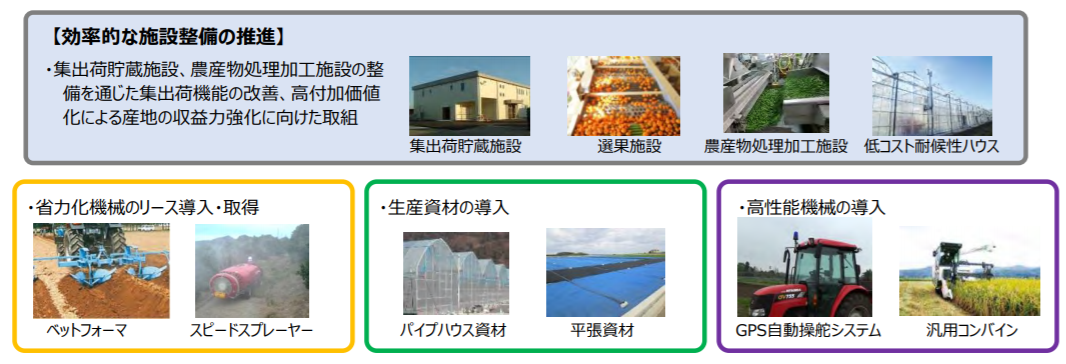
(Source: Ministry of Agriculture, Forestry and Fisheries website)
Subsidy rate
Subsidy rates are set differently for each of the above initiatives. For each of these, see below.
- Maintenance project”: within 1 / 2, etc.
- Leasing and acquisition of agricultural machinery: within 1 / 2 of the main price
- (2) Introduction of production materials: within 1 / 2 of the “Production Support Project
- (3) Re-planting of “Production Support Project”: fixed amount
Subsidy rate
Subsidy rates are set differently for each of the above initiatives. For each of these, see below.
- Maintenance project”: within 1 / 2, etc.
- Leasing and acquisition of agricultural machinery: within 1 / 2 of the main price
- (2) Introduction of production materials: within 1 / 2 of the “Production Support Project
- (3) Re-planting of “Production Support Project”: fixed amount
Measures to strengthen the production base
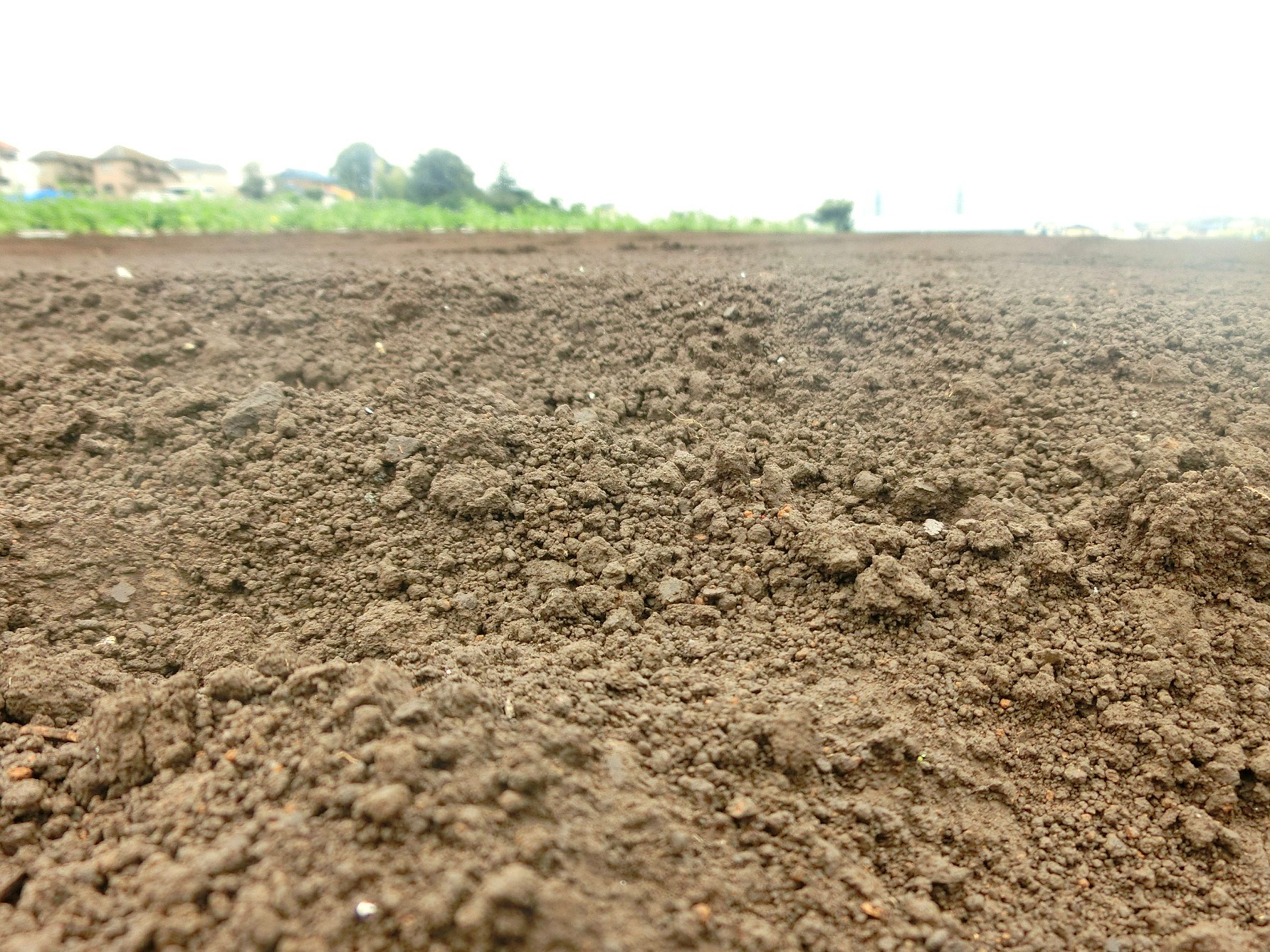
The “Production Infrastructure Strengthening Measures” support activities aimed at strengthening and passing on the production infrastructure and developing nationwide soil fertility.
For example, they will subsidize the following initiatives
- Rehabilitate and renovate agricultural greenhouses, orchards, tea gardens, etc.
- Matching of succession needs for smooth handover of production infrastructure to the next generation
- Lease introduction and acquisition of agricultural machinery
- Soil fertility and other efforts
In addition to setting “performance targets” that meet the same criteria as for “profitability improvement measures,” farmers who wish to rehabilitate or renovate their farms for succession must “have a plan to transfer the farm within five years,” or if the farm has already been transferred, “have a plan to start full-scale farming operations in the future. In addition to the above, the farmer is required to
Supported by
Farmers participating in the “Production Area Power Up Plan (Production Base Strengthening Type)” prepared by the Regional Agricultural Revitalization Councils, etc., and the following farmers’ organizations are eligible.
- agricultural cooperative
- agricultural cooperative
- qualified agricultural land ownership corporation
- Other organizations organized by farmers
Initiatives eligible for support and subsidy rates
This is also divided into “maintenance projects” and “fund projects,” with the following specific examples defined for each
Maintenance projects
- Rehabilitate low-cost weatherproof greenhouses and other facilities necessary to pass on the skills to new farmers and bearers of the farming industry.
Funded projects
- Rehabilitate and rehabilitate pipe houses for agricultural house transfers to new farmers and bearers
- Re-planning and renovation of orchards and tea gardens to start farming in the transferred orchards and tea gardens
- Re-maintenance and improvement of agricultural machinery in contract farming organizations, etc., for the purpose of passing on production functions in farmlands where there are no successors.
- Identification and matching of needs for succession of rehabilitated and renovated facilities and orchards, and purchase of equipment and production materials necessary for maintenance until succession at the recipient organizations.
- Demonstration of cultivation management, labor management, and other techniques to pass on and disseminate production techniques, and training to improve safe handling techniques for agricultural machinery
- Establishment of demonstration sites for the experimental use of cattle manure and pellet compost, etc.
Since the subsidy rate is set individually for each initiative, a table describing an example is attached below. The above is only an example. Those who wish to confirm detailed support details and subsidy rates should inquire at the relevant contact point in each prefecture.
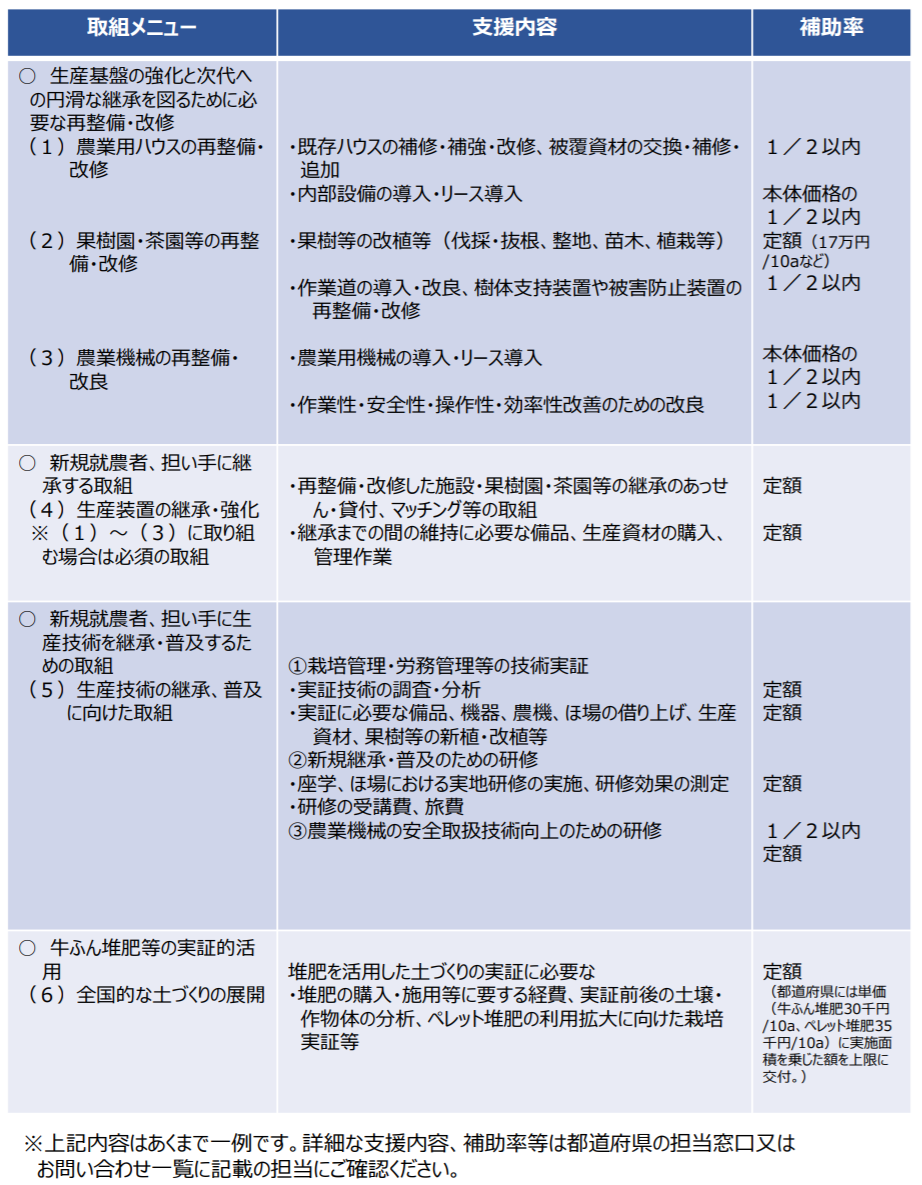
(Source: Ministry of Agriculture, Forestry and Fisheries website)
Procedural Flow of the Power Up Project for Production Bases in Production Areas

Regardless of which policy is used, the following procedures are to be followed when applying for the “Production Area Production Base Power Up Project”. Although it may seem complicated with many steps, it is mainly a simple process of “plan submission => grant application => grant issuance.
- (1) The subject person prepares the “Initiative Business Plan”.
- (2) Consult and submit business plans to the Regional Agricultural Revitalization Council, etc.
- (iii) Consultation and submission of business plans from the council to the prefectures
- (4) Prefectures consult and submit project plans to the national government and fund management organizations
- (5)-(7) National => Prefectural => Council => Target person, and the project plan is approved.
- (viii) The subject person applies to the prefectural government for the grant.
- (ix) Application for grant is made by the prefecture to the national government or the fund management organization.
- (10)-(11) The national government or fund management organization provides grants to eligible recipients through prefectures.
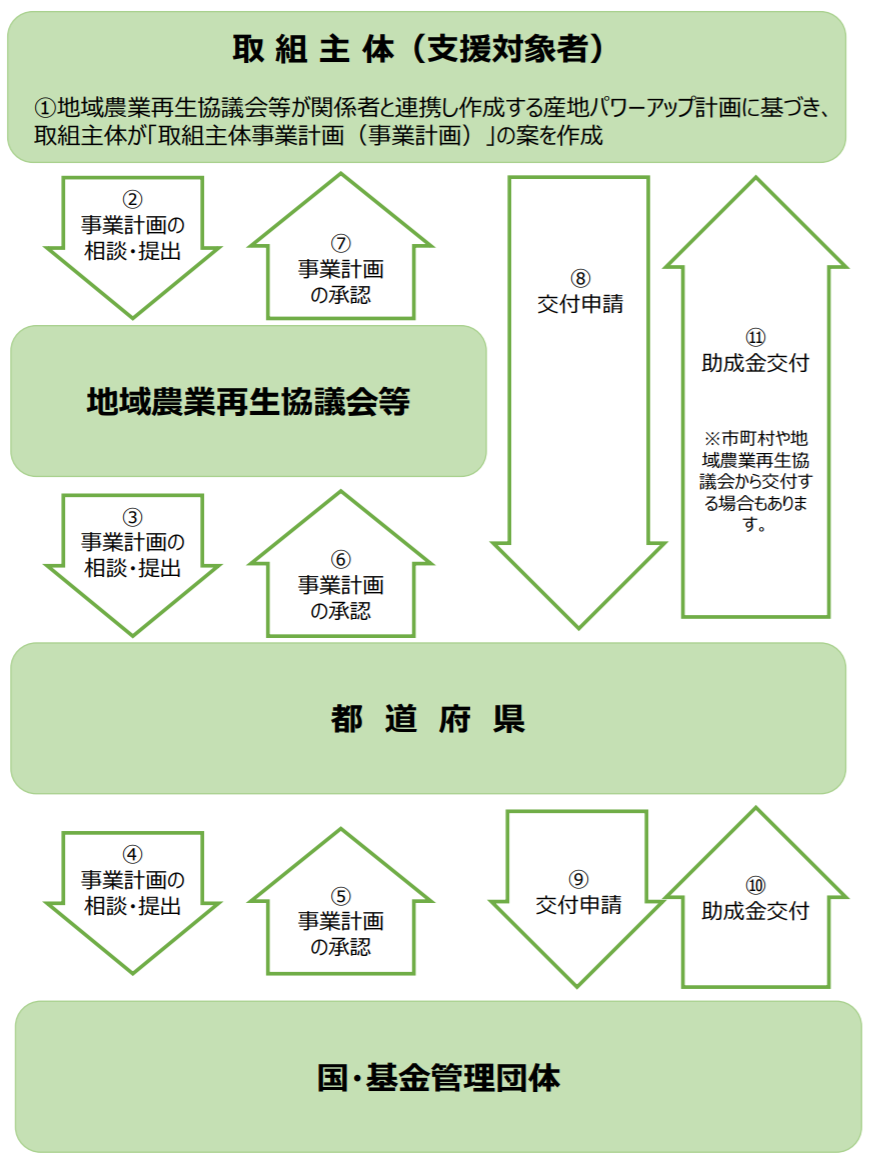
(Source: Ministry of Agriculture, Forestry and Fisheries website)
Example of Utilization of Production Area Production Base Power Up Project
A rice farmer in Fukushima Prefecture, who is engaged in online sales of “Amanotsubu,” a new variety of rice grown with fewer pesticides, used a grant to install a tent workshop. A grain dryer was installed in the tent workshop and is used for sorting rice.
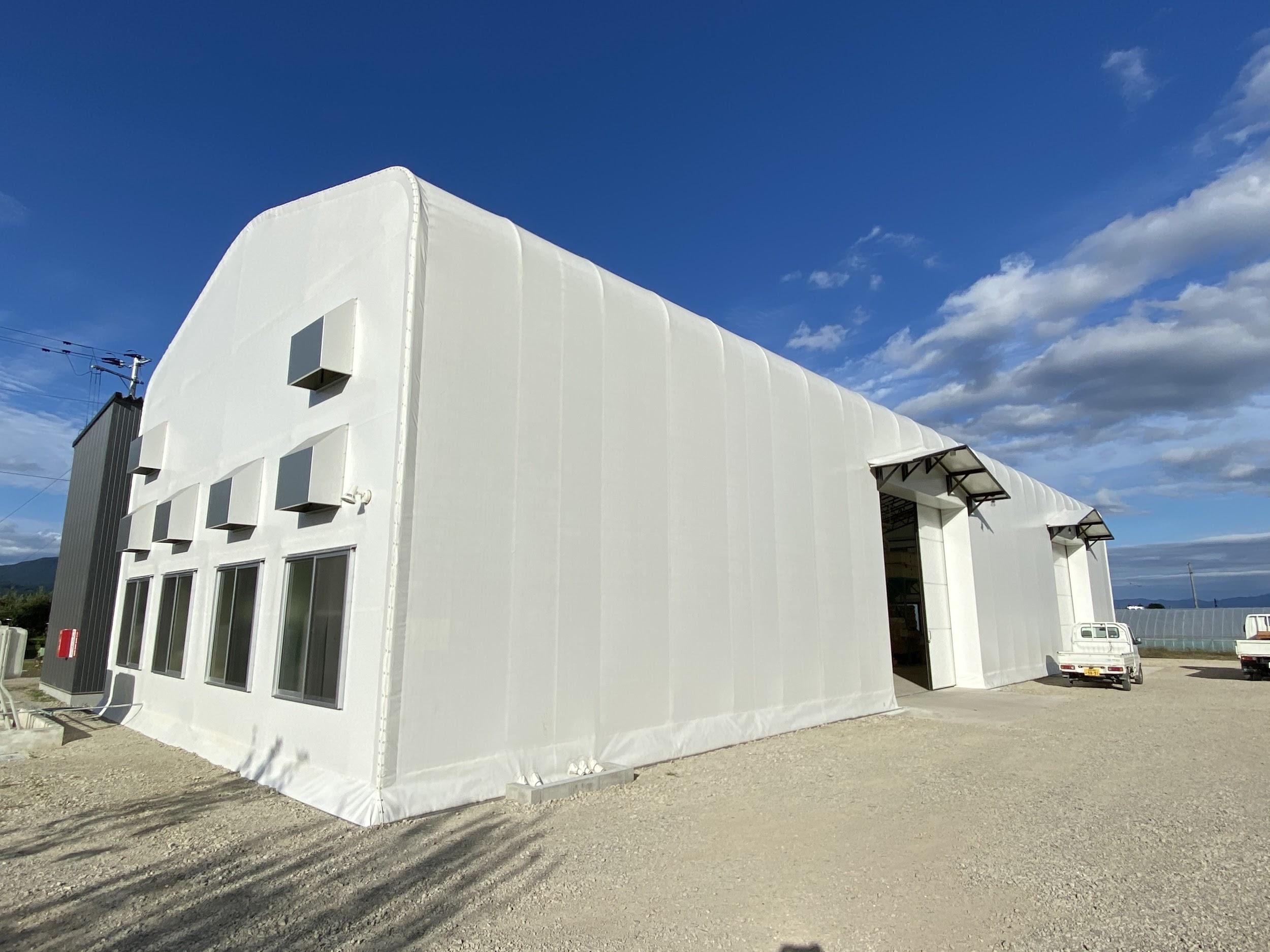
This dryer is shared by several farmers to improve the efficiency of the entire region. The rice farmer-manager took the initiative to gather young farmers in the neighborhood and apply as a group, which made them eligible for a subsidy under the “Production Area Production Base Power Up Project,” which is not available on a stand-alone basis. The installation was carried out by a local electrical equipment company instead of a design firm. In addition to the increased work efficiency that comes from sharing equipment, the gathering of surrounding farmers at this location has also contributed to the revitalization of the local community by stimulating communication.
summary
We hope that this article will help you gain a better understanding of grants and eliminate your difficulties.
We hope you will make use of the grant for the development of your business and for the prosperity of agriculture in Japan.
Please contact Taiyo Kogyo Corporation for information on products eligible for grants.
>> TAIYO KOGYO COMPANY, LIMITED│General Inquiries
Please contact the Ministry of Agriculture, Forestry and Fisheries regarding the grant program.
> “Ministry of Agriculture, Forestry and Fisheries Inquiry Desk
In addition to the Power Up Production Infrastructure Project, several other agriculture-related subsidies exist.
Please see this article for an overview.
> “3 Must-See Subsidy Programs for Farmers │ Summary of Subsidies You Can Receive”
Tent Warehouseへの
Any Inquries
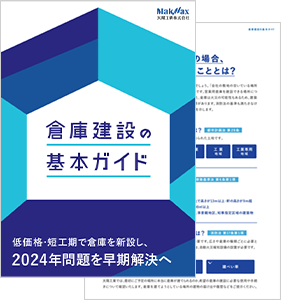
What you need to know when building a warehouse
We packed it all in.
Clues to solving the 2024 problem
Recommended for
I don't know where to start in building a warehouse.
I want to build a warehouse in an economical way.
Which type of warehouse should we build?
I want to learn the basics of warehouse construction anyway.
I'm concerned about the 2024 problem, but I don't know what to do about it.
Related Articles
- TOP>
- MakMax Plus>
- How farmers can improve their earnings by utilizing the MAFF’s “Production Area Production Base Power Up Project”.






